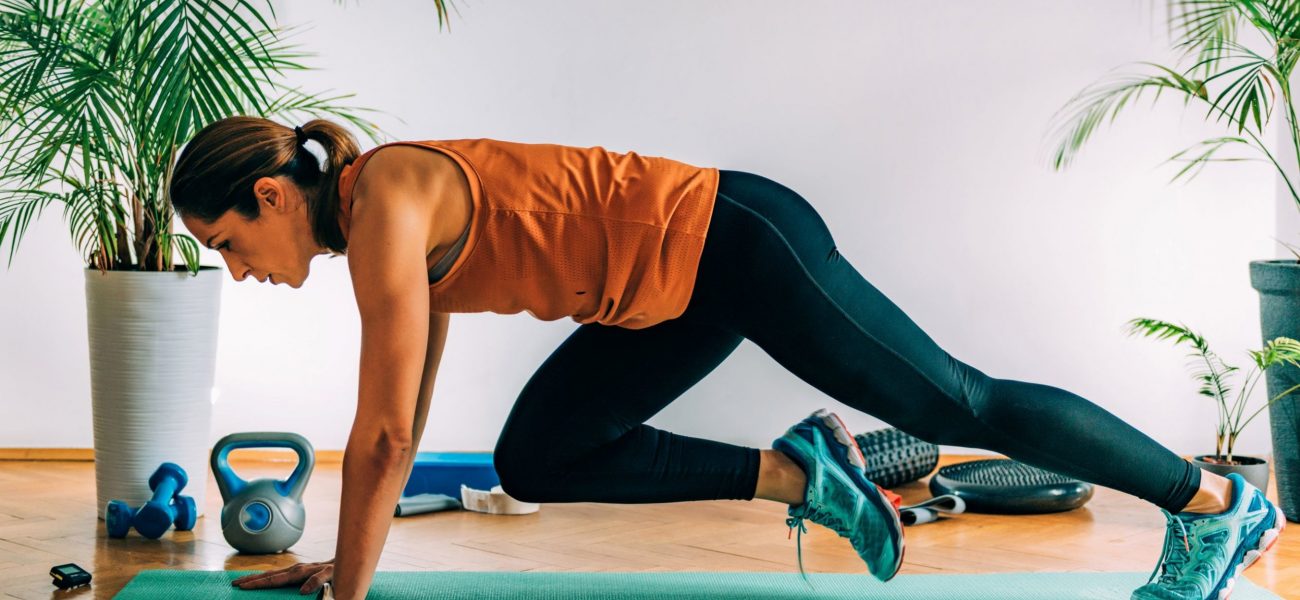First we learned the news from Professor Tabata in Japan that all we needed to lose body fat and get fitter than ever before was just four minutes of a high intensity cardiovascular exercise. Then more recently, scientists brought us seven-minute HIIT workouts, involving a series of resistance exercises that could be done at home with no more than a wall and a chair. Now new research has emerged from Abertay University in Dundee suggesting that two minutes of high intensity exercise is actually better than 150 minutes in a steady state.
Participants in this study, published in the journal Biology, completed 10 sprints of six seconds on a bike (with just two minutes rest time in total, not including warm up and cool down) twice a week. After eight weeks there was a significant improvement in their cardiovascular health and insulin sensitivity (the body’s ability to clear glucose from the bloodstream). HIIT in your weekly schedule could improve the way your body metabolises sugar too, according to a study in the Journal of Applied Physiology.
Even current NHS guidelines, which aren’t quite at the point of recommending a two-minute cardio workout, have begun to reflect the rising trend towards HIIT with weekly exercise prescriptions now including three options, with the amount of exercise time required per week reducing as the intensity goes up. Across the pond, HIIT also has its supporters: the American College of Sports Medicine says that 30 minutes of high-intensity exercise is as good as an hour at 60 percent effort, and a recent study comparing a lower volume of high intensity exercise versus higher volume at lower intensity found that the former significantly improved maximal oxygen uptake. So, if you want to feel these benefits of HIIT, read on!
The benefits of HIIT cardio
If you want to change your age at a cellular level, cardio is king. According to a study in the European Heart Journal, endurance exercises such as running, swimming and cycling are the best at slowing down the signs of ageing. In another study, people who took part in regular high intensity interval training (HIIT) improved their insulin levels, heart and lung health, and saw a reversal in age-related decline in mitochondrial function – that’s cell metabolism to you and I!
“Anti-ageing is about more than heaping on the creams, it’s about actively trying to lower your biological age,” says Keith McNiven, founder of London based personal training company Right Path Fitness. “Biological age is a combination of both your genes and how well you’ve looked after your body – and a huge indicator is heart health. If your biological age exceeds your actual age, you can have prematurely hardening arteries and thickening walls. Look after your heart by doing anything that gets your heart rate up. With regular cardio three to four times a week, you’ll lower your maximum heart rate and keep it as young as it can be.”
Increase your endurance
Performance expert and London-based personal trainer Gus Olds says: “People at a high fitness level preparing for endurance events, for example, often undervalue the importance of anaerobic threshold training and choose instead to just focus on exercising for longer and longer periods of time at the same old intensity. Pushing yourself ‘at threshold’ (ie. at a point you can’t hold for long) regularly, when combined with steady state training, will help increase your endurance far more than just doing steady state training.”
Nike trainer and sponsored athlete Gemma Bailey is also a fan of HIIT and uses it every day with clients. But she admits it does require respectful caution, particularly with regards to beginners: “HIIT delivers huge benefits,” she says. “For example, short sprints will build muscle, whereas long distance running burns it. HIIT is also a fast way to burn fat. But it does have its disadvantages. Because you’re doing things at speed, it’s all too easy to compromise on good form (ie. keeping your body positioned correctly and moving well), and form should come first.”
How to practise HIIT safely
Exciting, effective and time-efficient, it would seem that HIIT, the technique that consists of short bursts of explosive movement followed by rest periods, can do no wrong. After a session only 20-30 minutes long, your resting metabolic rate stays raised for the next 24 hours, meaning that the fat burning isn’t over once you step off the treadmill, it just keeps going and going. Sounds ideal, right?
However, as the fitness world wholeheartedly embraces the high-impact approach, top doctors believe that it could be to blame for an increase in the number of people under 30 years old suffering from hip, knee and back problems. Despite the well-documented benefits, does this mean the intense approach needs to be avoided? Well, not if you read our advice below on how to swerve all the common HIIT mistakes…
HIIT for absolute beginners
You’ve signed up to the gym, bought your trainers and decided it’s time to get fit and boost your health – congratulations! However, before diving headfirst into the latest workout trend and taking on too much too soon, it’s worth being realistic about your current fitness levels in order to avoid injury.
One of the great things about HIIT is that there are many different ways to carry it out, from treadmill sprints to weighted routines. However, if you’re starting out as a total beginner, Puma trainer Jay Copley suggests you use your own bodyweight to perform your HIIT training. “There’s nothing better than getting to grips with understanding how your own body moves. When you begin to feel more confident, then you can start to explore other avenues, such as the treadmill,” he says. To avoid taking on too much too soon, Jay also advises working on a quality programme that builds up the workout intensity over time. “For example, start with a 15-minute session and increase the time by five minutes each week until you reach 30 minutes.”
Remember to warm up before exercise
Warming up your muscles is one of the most important parts of any kind of workout, but failing to limber up for an intense HIIT session is a recipe for disaster. By stretching before going into the hard work, you’re increasing your muscle elasticity, which means they perform better and are less likely to get injured.
The best way to warm up for a HIIT session is to mimic the movements you’ll be carrying out in the main workout routine. So, if you’re planning on sprinting, warm up with a light jog for five to 15 minutes, or go through the moves for a few light reps beforehand to make sure you have the correct form for when you hit it hard in the real thing.
Avoid HIIT overtraining
The short nature of HIIT workouts (which are never longer than 30 minutes) can often lead to people believing that there’s no problem with performing them every day. However, if you have done a HIIT workout properly, then your muscles will be well and truly exhausted, and so rest and recovery in between is key.
Knowing the exact amount of time your body needs to recover from HIIT training is tricky to calculate, especially when trainers and programmes advise different things. Personal trainer Callum Melly, for example, strongly advises against workouts without a 48-hour gap in between: “The current trend of bodyweight HIIT circuits on a regular basis (often recommended at four to five times per week) if completed at maximal effort to make it effective, means it’s impossible to maintain safe form for your body. HIIT is extremely taxing on the body and the central nervous system, and can cause significant wear and tear to muscles and joints. I would only recommend this twice a week for no longer than 20 minutes, integrated into a resistance workout.”
Jay, while agreeing that overtraining leads to a higher chance of injury, instead advises a maximum of three HIIT workouts a week to complement your other training. We think the key here is balance and listening to your body.
Be careful if you’re recovering from an injury
As you might have gathered from the name, high intensity exercise isn’t exactly easy on the joints, so if you suffer from an old injury already, chances are this type of workout could cause it to flare up again. However, that’s not to say you have to ditch HIIT altogether…
As we’ve already mentioned, HIIT is a versatile way of training that can be performed a variety of ways, so if you’re nursing an injury or want to avoid a new one, simply opt for a low-impact method. Why not try sprints in the pool, or swap the treadmill out for the cross trainer, which still works your body but has less impact on the knees? Don’t have a gym membership? You can still train using bodyweight exercise; just focus on moves that won’t pound your joints, such as seated tuck jumps and walkdown push-ups. An added bonus is that this way your routine will be quieter – ideal for those early morning exercisers who don’t want to wake the whole house!
Whether it’s playing with the timings of the recovery period, reducing the number of times you work out per week, or simply opting for low-impact methods and moves, the good news is that HIIT can be a great, effective workout for everyone when tweaked to your age and fitness levels.
In order to progress and see results you need to work hard and keep pushing yourself, but the effort should always be just within the realms of your ability – not to the point of extreme discomfort or pain. Always listen to your body and you can reap the benefits of HIIT training safely and successfully.
What are the best HIIT exercises?
HIIT moves using a weight plate
Try these moves from Dave Kyle, head trainer at Les Mills UK.
Plate front press squat jump
- Squat jumps sculpt and tone thighs and calves. From a squat position jump as high as you can reaching as high as you can with arms overhead. Repeat for two sets of 15 reps.
Plyo lunges
- Stand in a split stance, right leg in front and left leg back. Bend your knees and lower into a lunge, keeping the front knee behind the toe.
- In an explosive movement, jump into the air and switch your legs, landing so that the left leg is in front and the right leg is back. Land with soft joints, lower into a lunge and repeat, jumping and switching sides. Complete two sets of 15 reps.
Forward leap plate extension
- Hold the plate close, then extend the arms out and at the same time perform a squat.
- As you return to the standing position, with fast feet, run back. Perform a squat and extend the arms and then run forward again to the start position. Complete for two sets of 15 reps.
Plate front squat press
- Push the weight over your head as you perform deep squats. Complete two sets of 15 reps.
Lateral fast feet with plate extension
- Push the weight out in front of you and keep it at shoulder height. Perform a squat, and then with fast feet, take about 4-6 steps to the side.
- Perform a squat and return to the centre to perform again on the other side. Complete for two sets of 15 reps.
Skaters
- Stand up, abs embraced. Leap from side to side as if you are skating.
- Extend your arms from side to side as you move. Complete for two sets of 15 reps.
Tuck jump
- Stand with your feet just outside hip-width. Sit down and back until your hips are just above the knee line. Throwing the hands over head, jump up as high as you can, tucking the knees in towards the chest.
- Land through the ball of the foot with soft knees, rolling on to the heel to absorb the impact and repeat. Your chest should be kept up throughout to maintain good upper body posture. Do three sets of 10.
15-minute beginner HIIT workout
Professional PT Kristoph Thompson has selected five exercises to work your upper body, lower body and core, as well as increasing your cardio fitness. For best results, aim to stay as engaged as you can throughout the workout, keeping rest to a minimum. This is possible because the exercises are ordered in a way to ensure that while one part of your body is working, the remaining parts are recovering. Perform 30 seconds of each exercise in Pair A, followed by 30 seconds of mountain climbers. Repeat this six times then move onto Pair B, followed by another set of 30 seconds of mountain climbers, performing another six rounds to complete the workout.
Pair A: lunge
- Begin standing with your feet hip-distance apart, holding a dumbbell in each hand for added difficulty. Take a step forward with your right foot, pausing for a second to get your balance if necessary, then bend your hips and knees to come into a lunge.
- Your back knee should be just above the floor, with both hips and knees bent to 90 degrees, your torso upright and in line with your back thigh. Your front knee should not come further forward than your toes and remain in line with your ankle (rather than moving in or out to the side).
- Push through the front foot, straightening your legs to return to the start, then repeat on the other leg to complete one rep.
Pair A: triceps extension
- Begin standing, holding a dumbbell in each hand with your arms straight above your head and your palms facing each other.
- Bend your elbows to 90 degrees, taking your hands behind your head while trying to keep your upper arms pointing straight upwards.
- Straighten your arms to return to the start and repeat.
- Aim to keep your shoulders down away from your ears throughout, as well as trying not to arch your lower back or allowing your chest to move upwards or stick out.
Pair B: squat and press
- Begin standing with your feet a little wider than hip-width apart, holding dumbbells in each hand, level with your shoulders.
- Bend your hips and knees to come into a squat position, aiming to reach a point where your hips are a little higher than your knees, with your back straight. Make sure the whole of your foot remains in contact with the floor, and your knees track in line with your toes.
- Straighten your legs to return to standing and press the dumbbells overhead. Bend your arms to return to the starting position, then repeat.
Pair B: single-arm row
- Holding a dumbbell or kettlebell in your right hand, begin with your left hand and lower your left leg on a bench, with your hip directly above your knee and your shoulder directly above your wrist. Your right foot should be placed firmly on the floor, with the knee bent slightly so that your hips are level. When viewed from the side, your back should be straight.
- Initiate the movement by squeezing between your shoulder blades, then bend your right arm to bring the dumbbell towards your lower ribs, keeping your elbow close to your side as you do so. Reverse the movement to return to the start, then repeat.
Mountain climbers
- From the top of a push-up position, step one foot in towards your hands. This is your starting position.
- Jump the front foot back, while bringing the other foot forwards, then quickly reverse the movement.
- Continue, moving as fast as you can, staying on the balls of your feet. Try to straighten the back leg with each rep, without allowing the back foot to creep closer to your hands as the set progresses. Count how many reps you do in 30 seconds and aim to reach this target, or exceed it, with each successive set.
Fat loss exercises
The experts at Total Fitness have put some of their favourite moves together that will help to work all the key muscle groups, help with weight loss, and get you in shape. Carry out each exercise for 45 seconds, then rest for 15 seconds before moving onto the next. Repeat the five-minute circuit as many times as you like.
High knees
A great way to warm up while targeting your lower abs is to give yourself a quick blast of cardio in the form of high-knees. To complete this simple cardio-intensive exercise, start from standing position and run on the spot as fast as you can, raising each knee so it’s on a 90-degree angle to the floor. This exercise engages the core and works the leg muscles whilst getting your heart rate up.
The superman
- Strengthen your lower back and abs with the superman pose. Start by lying on your front with arms and legs extended away from you.
- Raise your arms and legs off the floor simultaneously and engage your core to lift your chest off the floor a little.
- Hold for a few seconds before returning to your start position. For a more advanced exercise, whilst in the hold position, move your limbs in criss-cross motion as though making a snow angel.
Ball slams
The original ball slam is a great way to elevate the heart rate quickly whilst developing core strength, positioning itself as a fantastic calorie-burner.
- Stand with your feet hip-width apart, squat down keeping your back straight, drive the ball upwards with your arms fully extended and the ball overhead, then accelerate downwards back into the squat position slamming the ball into the ground on the way down.
- Try and catch the ball on the bounce and keep it fast-paced for a great cardio/strength training workout.



















